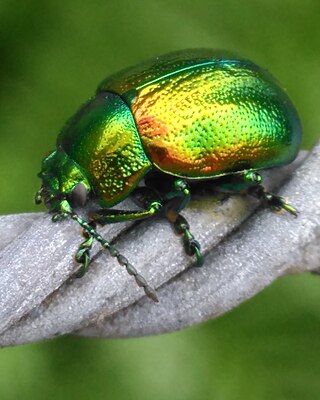
The tansy beetle is a species of leaf beetle. The common name derives from its main foodplant, tansy, but it can also use other wetland plants such as gypsywort and water mint. It measures 7.7–10.5 mm in length and has a characteristic bright metallic green colouration, with pitted elytra and a coppery tinge. In addition to the nominotypical subspecies, which repeats the specific name, C. graminis graminis, there are five further distinct subspecies of tansy beetle, which, collectively, have a Palearctic distribution, although in the majority of countries where it is found the species is declining. In the United Kingdom it is designated as 'Nationally Rare'. The stronghold population here is located along the banks of the river Ouse in York, North Yorkshire. Other, small, fenland populations exist at Woodwalton Fen and at Welney Wildfowl and Wetlands Trust (WWT) reserve.
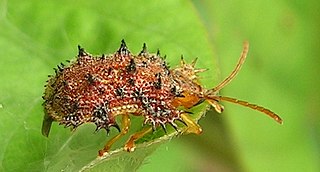
The Cassidinae are a subfamily of the leaf beetles, or Chrysomelidae. The antennae arise close to each other and some members have the pronotal and elytral edges extended to the side and covering the legs so as to give them the common name of tortoise beetles. Some members, such as in the tribe Hispini, are notable for the spiny outgrowths to the pronotum and elytra.
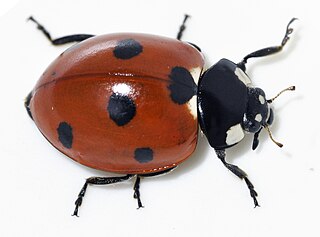
Coccinellidae is a widespread family of small beetles. They are commonly known as ladybugs in North America and ladybirds in the United Kingdom; "lady" refers to mother Mary. Entomologists use the names ladybird beetles or lady beetles to avoid confusion with true bugs. The more than 6,000 described species have a global distribution and are found in a variety of habitats. They are oval beetles with a domed back and flat underside. Many of the species have conspicuous aposematic (warning) colours and patterns, such as red with black spots, that warn potential predators that they taste bad.

Parthenium hysterophorus is a species of flowering plant in the family Asteraceae. It is native to the American tropics. Common names include Santa-Maria, Santa Maria feverfew, whitetop weed, and famine weed. In India, it is locally known as carrot grass, congress grass or gajar ghas or dhanura. It is a common invasive species in India, Australia, and parts of Africa.
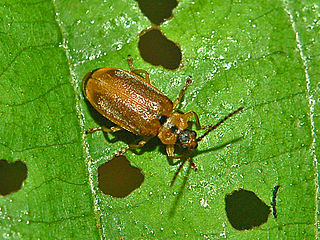
Galerucella is a genus of leaf beetles in the family Chrysomelidae described by George Robert Crotch in 1873. It is widely distributed but absent in the Neotropics. Some species feed on waterlilies and are used as biocontrol of introduced, invasive waterlilies. Galerucella tenella feed on strawberry plants.

Calligrapha is a large genus of American Chrysomelinae, with over 100 species occurring from North America through Central America.

Calligrapha disrupta is a species of leaf beetle belonging to the family Chrysomelidae, in the subgenus Zygogramma, which was formerly a genus.
Calligrapha arizonica is a species of leaf beetle belonging to the family Chrysomelidae, in the subgenus Zygogramma, which was formerly a genus.

Calligrapha conjuncta is a species of leaf beetle belonging to the family Chrysomelidae, in the subgenus Zygogramma, which was formerly a genus.
Calligrapha continua is a species of leaf beetle belonging to the family Chrysomelidae, in the subgenus Zygogramma, which was formerly a genus.
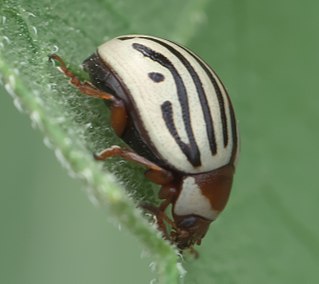
Calligrapha exclamationis, commonly known as the sunflower beetle, is a species of leaf beetle belonging to the family Chrysomelidae, in the subgenus Zygogramma, which was formerly a genus. It is regarded as a pest of sunflower crops in North America.

Calligrapha suturalis, commonly known as the ragweed leaf beetle, is a species of leaf beetle belonging to the family Chrysomelidae, in the subgenus Zygogramma, which was formerly a genus. Native to North America, it has been introduced into Russia and China for the biological pest control of ragweed.
Calligrapha heterothecae is a species of leaf beetle belonging to the family Chrysomelidae, in the subgenus Zygogramma, which was formerly a genus.
Labidomera suturella, commonly known as the tropical milkweed leaf beetle is a species of beetle from the family Chrysomelidae.
Calligrapha opifera is a species of leaf beetle belonging to the family Chrysomelidae, in the subgenus Zygogramma, which was formerly a genus.. It is found in Central America and North America.
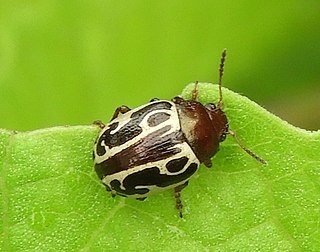
Calligrapha piceicollis is a species of leaf beetle belonging to the family Chrysomelidae, in the subgenus Zygogramma, which was formerly a genus. It is found in Central America, North America, and Europe.

Calligrapha signatipennis is a species of leaf beetle belonging to the family Chrysomelidae, in the subgenus Zygogramma, which was formerly a genus. It is found in Central America and North America.

Calligrapha tortuosa is a species of leaf beetle belonging to the family Chrysomelidae, in the subgenus Zygogramma, which was formerly a genus. It is found in Central America and North America.
Calligrapha malvae is a species of leaf beetle belonging to the family Chrysomelidae, in the subgenus Zygogramma, which was formerly a genus.. It is found in Central America and North America.
Notosacantha vicaria is a species of leaf beetle native to India, and Sri Lanka.













